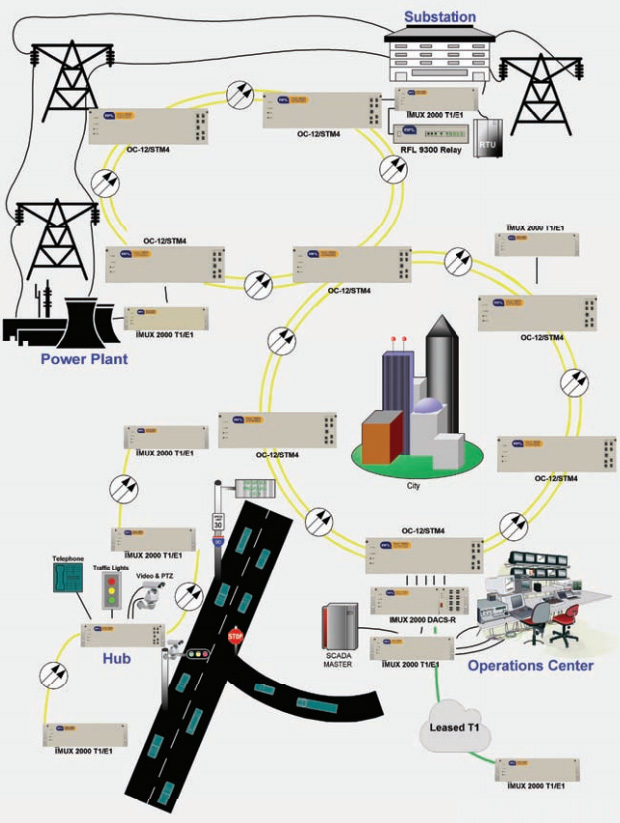Substation Hardened
The IMUX 2000 T1/E1 Multiplexer is designed for harsh environments and has a wide temperature range of -20°C to +65°C. It meets the IEEE/ANSI standards C.37.90-1989, C.37.90.1 and C.37.90.2 for SWC, fast transient and EMI. It is CE approved and has been tested to BS EN 5002:1995. It is also FCC part 15 Class A approved.
Reliability
The IMUX 2000 provides enhanced reliability by offering optional redundant power supplies and common logic modules.
Speed
The IMUX 2000 is designed to handle time sensitive applications such as Protective Relaying. The Drop-and-Insert through-channel delay is less than 25 microseconds. The IMUX 2000 has an average reframe time of less than 25 milliseconds and also has the ability to enable a Fast Reframing Channel (FRC) for less than 1 millisecond reframing.
DS0 Squelching
The IMUX 2000 T1/E1 Multiplexer has the ability to squelch (turn off) the output of a channel module in the Multiplexer upon loss of synchronization. This feature provides security against false tripping on 4-wire analog transfer trip channels and older digital equipment (with limited error checking) during loss of sync and protects against ‘pink’ noise conditions, which result from cross-talk or the frame search. This feature is ideal for preventing false tripping due to system malfunction.
CSU Functionality
The IMUX 2000 offers a built in CSU functionality that meets applicable standards for protection including FCC Part 68 approval for direct connection into the Public Switched Telephone Network (PSTN). When enabled, the unit will respond to generated loopback codes compliant to either ANSI T1.403 or AT&T TR 54016. It will also maintain and allow local and remote retrieval of performance measurements in accordance with either ANSI T1.403 or AT&T TR 54016.
Modular Design
The IMUX 2000 incorporates a midplane motherboard design. Channel modules plug into the front of the unit, and matching module adapter for I/O connections plug into the rear. This eliminates the need for internal chassis wiring when adding new channel cards, simplifying the upgrade.
Fiber Optic or Electric Interfaces
The IMUX 2000 can be equipped with either electrical T1/ E1 interfaces or Optical Interface Adapters (OIA’s). The electrical T1 interface is equipped with Line Build-Out (LBO) networks for operation of up to 6,000 feet from the DSX. The OIA’s are available in a wide range of multimode, single-mode, LED or laser combinations to accommodate 1300nm and 1550nm wavelengths.
Channel Interfaces
A wide range of interfaces unique to the utility and the transportation market is offered. It also offers a wide range of Voice and Data, Status, Telemetry, Ethernet, Transfer Trip and Video channel interfaces to meet most communications requirements.
Fast Restoration
When applied to diverse communication routes, such as Ring or Hot-Standby networks, the IMUX 2000 is capable of switch times programmable down to 1 millisecond.
Diverse Networks
The IMUX 2000 supports many types of network layouts such as Linear, Spurs, Hot-Standby and Ring topologies. It is also designed for operation over SONET/SDH networks taking into consideration the critical time-delay issues associated with Protective Relaying.
SONET and SDH Applications
Protective Relaying can finally be applied over non-proprietary SONET/SDH equipment. With emphasis placed on rapid break healing, the IMUX 2000 addresses the critical time issues associated with Protective Relaying making it the ideal and Intelligent choice when interfacing to SONET/ SDH networks. The IMUX 2000 bridges the gap between SONET and substations providing DS0 gateways onto the network. Also, through its own switching techniques, can overcome the longer switch times and unequal channel delay issues associated with SONET.
Automation
The IMUX 2000 offers the ultimate Network Management system which operates in a Windows TM point-and-click environment. The optional SNMP based management reporting software can be used when integrated as part of a larger enterprise system. Network visibility is available from any node which allows remote provisioning, monitoring and alarm reporting.




